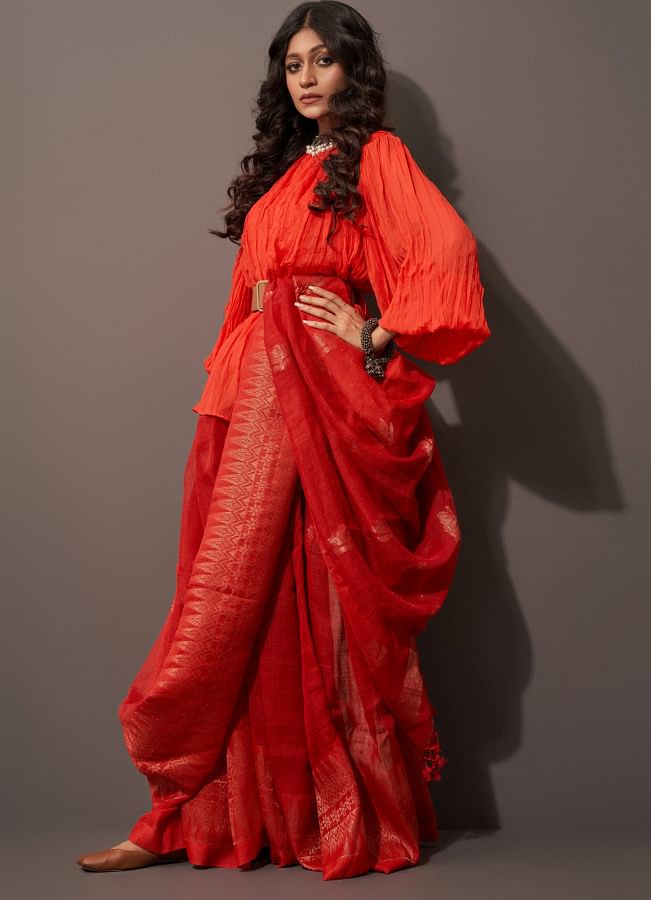Draping through time: Contemporary twists on the classic sari

The sari, an emblematic attire of South Asian heritage, is not just a garment but a canvas that embodies tradition, elegance, and cultural identity. From time immemorial, this heritage has been passed down to us from our mothers and grandmothers and the generations before them. Yet, the draping of the sari keeps evolving. How the new generation is putting a fresh spin on this six-yard garment is truly amazing and our love for saris remains the same. So, let us walk you through the modern draping styles and the changing trends that are redefining this classic attire.

The classic drapes
When we think of wearing the sari, the nivi drape naturally comes to mind. It involves tucking one end of the sari into the waistband of a petticoat, wrapping it around the waist, and then draping the other end (the anchal) over the shoulder. The modern twist to the nivi drape includes experimenting with blouse designs, adding belts for a chic look, or even altering the anchal's fall for a more contemporary aesthetic.

There is a common misconception that a sari is a six-yard garment, but it is not! Saris can range from three yards to nine yards in length. This is where the traditional South Indian drape or the Madisar, comes in: an eight-to-nine-yard sari style typically worn by the ladies in Tamil Nadu. Unlike the nivi, it does not require a petticoat. It's wrapped around the body with a portion going between the legs and tucked at the back, resembling a pair of trousers for ease of movement.
On the other hand, the Bengali drape is renowned for its unique and traditional style. This drape is characterised by its main feature: the sari is wrapped around the waist, with two pleats placed in the front. The most distinctive aspect of the Bengali drape is the anchal, which comes from the back over the right shoulder, is then brought up under the right arm and once again thrown over the left shoulder. This double-layered anchal, often with exquisite borders, creates a graceful and cascading effect.

The avant-garde draping styles
Today's young generation does not want to confine themselves to a fixed way of wearing a sari. Therefore, changes are taking place.
A hit among the younger crowd, the pant-style sari involves draping the sari over pants or leggings instead of the conventional petticoat. It's not only chic but offers ease of movement, making it a preferred choice for working professionals.
Furthermore, adding a belt to cinch the waist while wearing a sari is a trend that has gained immense popularity. It adds a modern twist, accentuates the waistline, and keeps the anchal in place, offering both style and functionality.

A new trend in town is the neck-drape style, which involves draping the anchal around the neck like a scarf. This style is not just trendy but also practical for those who are not comfortable managing a flowing anchal.
Lastly, the advent of pre-stitched saris is a boon for those who find the traditional draping process cumbersome. These ready-to-wear saris ensure the elegance of a perfectly draped sari without the hassle of pleating and pinning.

Reinvention of the blouse
The transformation of sari blouses over the years is equally noteworthy. Youngsters are nowadays reinventing the art of wearing a blouse – from crop tops, and off-shoulder blouses to jacket-style blouses – new trends are emerging now and then.
A popular trend is the use of crop tops as blouses. These offer a youthful and chic look, pairing well with both traditional and modern saris. Peplum blouses, with their flared waists, add a Western twist and are often chosen for their flattering silhouette.
Additionally, incorporating elements from Western wear, jackets and cape-style blouses adds a unique layer to the sari. These styles range from embroidered ethnic jackets to sheer capes, offering both elegance and a touch of modernity.
Similar to jackets and cape-style blouses, off-shoulder and cold-shoulder blouses are now commonly paired with saris. These designs are particularly favoured by younger women and add a contemporary edge to the sari.
The appeal of the sari is timeless, but that does not mean we cannot experiment with its draping. From Nivi to pant-style sari, many old trends are competing with the new ones. Yet, these styles, whether traditional or infused with modern elements, represent a rich cultural tapestry – along with the changing nature of fashion and the ability of the sari to evolve with time.
Model: Mashiat, Tabinda
Styling: Sonia Yeasmin Isha
Wardrobe: Kathgolap
Mua: Piash

 For all latest news, follow The Daily Star's Google News channel.
For all latest news, follow The Daily Star's Google News channel. 







Comments